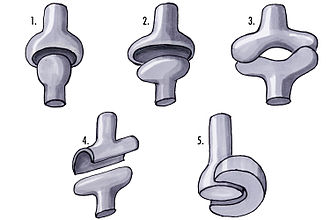| Saddle Joint | |
|---|---|
 1: Ball and socket joint; 2: Condyloid joint (Ellipsoid); 3: Saddle joint; 4 Hinge joint; 5: Pivot joint; | |
 Ligaments of wrist. Posterior view. | |
| Details | |
| Identifiers | |
| Latin | articulatio sellaris |
| TA98 | A03.0.00.048 |
| TA2 | 1560 |
| FMA | 75298 |
| Anatomical terminology | |
A saddle joint (sellar joint, [1] [2] articulation by reciprocal reception[ citation needed ]) is a type of synovial joint in which the opposing surfaces are reciprocally concave and convex. It is found in the thumb, the thorax, the middle ear, and the heel.